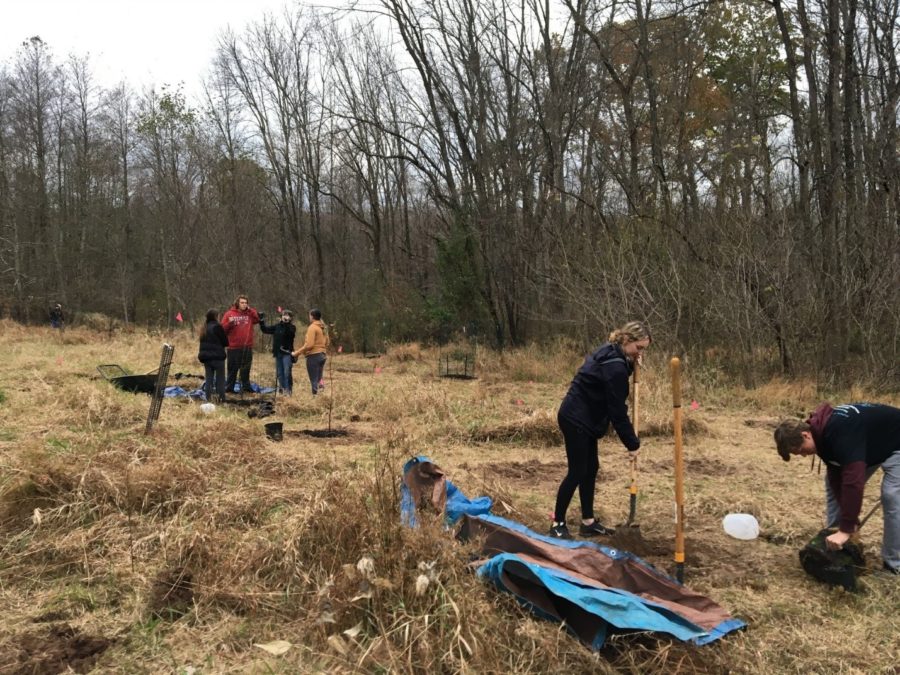Through the Intro to Environmental course at Bucks, students have begun to plant roughly 300 native trees and shrubs from Pennsylvania by the Covered Bridge Trail in Tyler State Park.
Dr. Kathi Knight, a professor of Biology and Environmental Studies at Bucks planned the tree planting project. Knight explained that the tree planting project is part of the service learning curriculum in the introductory environmental science course at Bucks. Students in Knight’s class along with other volunteers have been working since the first week of the semester to restore the trail.
At first, the students worked on a meadow restoration project, to bring in more pollinators such as Monarch butterflies and bees. After a few weeks, they then moved onto a section of Tyler State Park to clear trails and cut suffocating vines around trees.
The class has now moved to a field on the Covered Bridge Trail where they began the process of planting 249 trees, 40 shrubs and 80 perennials. At 4.9 acres the Covered Bridge Trail is a historic attraction in Tyler State Park.
The project is being funded by Pennsylvania Horticultural Society, who granted $10,000. The BCCC Foundation matched the amount to a total $30,000 in funds.
The students first arrived in the middle of October and have been coming almost every Tuesday and Thursday, weather permitting. Some of the students were excited right from the beginning.
Bryce Rose, a 21-year-old psychology major from Doylestown, said “It looked like a pretty cool option when signing up for classes. Now I know that it’s a great experience and place for people to interact while also helping out the environment.”
All the trees and shrubs that are being planted are completely native to Pennsylvania. This means that these are the plants that were here hundreds of years ago and were not synthetically produced to have appealing characteristics.
A high school student from Yardley, 18-year-old Brooke Kersten, is proud of the work that has been produced.
“I’ve always been interested in Environmental Science and finding new ways to better the environment. This project gave me a new appreciation for the people who do this for a living and the amount of time and effort that goes into planting one tree,” said Kersten.
The hope for this project is that the trees and shrubs will act as a watershed from water runoff. The plants are also supposed to provide habitats for multiple species. For example, there should be 200-300 insects per tree which adds biodiversity to the ecosystem.
Andrew Flick, an 18-year-old Environmental Science major from Yardley, believes this type of work should be more popular.
“It’s way easier than I thought it would be. We can plant a tree in a few minutes! I feel if more people would do this than this (the crisis of deforestation) wouldn’t be much of an issue. It doesn’t take too much time out of your day,” said Flick.
The students have worked the project on days where its been hot, cold, windy and drizzling just to make sure they can plant the trees in time before winter hits. Even though some of the days were terrible conditions, the students are still happy to help.
Environmental Science major Richard Brown, a 25-year-old from Croydon, thinks the tree planting program is great learning experience.
“I’ve dug holes, learned to properly plant the trees while learning to stake them with the help of others. There was even a guy who came to help that took this class previously years ago. I mean, this was just a field of grass and now there’s a bunch of trees,” said Brown with an excited grin.
The students really seemed that they got a lot out of this service-learning class. Mary Robinson, a 19-year-old Environmental Science major from Doylestown, can’t wait for the project to be finished. She said, “I feel like once it’s all done and we can see it all together, it’s going to be really rewarding. We can really appreciate all of our hard work.”
To find out how to help with the Cover Bridge Trail Restoration project, contact the head of the project Knight at [email protected].


